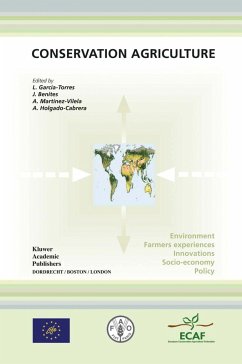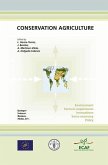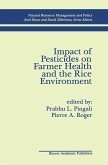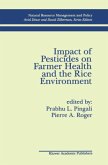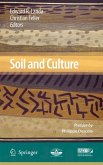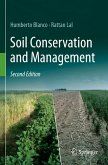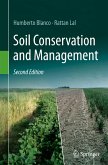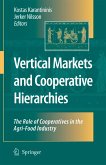García-TorresEnvironment, Farmers Experiences, Innovations, Socio-Economy, Policy
Conservation Agriculture
Environment, Farmers Experiences, Innovations, Socio-Economy, Policy
Herausgegeben:García-Torres, L.; Benites, J.; Martínez-Vilela, A.
García-TorresEnvironment, Farmers Experiences, Innovations, Socio-Economy, Policy
Conservation Agriculture
Environment, Farmers Experiences, Innovations, Socio-Economy, Policy
Herausgegeben:García-Torres, L.; Benites, J.; Martínez-Vilela, A.
- Gebundenes Buch
- Merkliste
- Auf die Merkliste
- Bewerten Bewerten
- Teilen
- Produkt teilen
- Produkterinnerung
- Produkterinnerung
In large parts of the developed and developing worlds soil tillage by plough or hoe is the main cause of land degradation leading to stagnating or even declining production levels and increasing production cost. It causes the soil to become more dense and compacted, the organic matter content to be reduced and water runoff and soil erosion to increase. It also leads to droughts becoming more severe and the soil becoming less fertile and less responsive to fertiliser.
This book brings together the key notes lectures and other outstanding contributions of the I World Congress on Conservation…mehr
Andere Kunden interessierten sich auch für
![Conservation Agriculture Conservation Agriculture]() Conservation Agriculture149,99 €
Conservation Agriculture149,99 €![Impact of Pesticides on Farmer Health and the Rice Environment Impact of Pesticides on Farmer Health and the Rice Environment]() Prabhu L. Pingali / Pierre A. Roger (Hgg.)Impact of Pesticides on Farmer Health and the Rice Environment153,99 €
Prabhu L. Pingali / Pierre A. Roger (Hgg.)Impact of Pesticides on Farmer Health and the Rice Environment153,99 €![Impact of Pesticides on Farmer Health and the Rice Environment Impact of Pesticides on Farmer Health and the Rice Environment]() Impact of Pesticides on Farmer Health and the Rice Environment153,99 €
Impact of Pesticides on Farmer Health and the Rice Environment153,99 €![Soil and Culture Soil and Culture]() Soil and Culture154,99 €
Soil and Culture154,99 €![Soil Conservation and Management Soil Conservation and Management]() Humberto BlancoSoil Conservation and Management75,99 €
Humberto BlancoSoil Conservation and Management75,99 €![Soil Conservation and Management Soil Conservation and Management]() Humberto BlancoSoil Conservation and Management97,99 €
Humberto BlancoSoil Conservation and Management97,99 €![Vertical Markets and Cooperative Hierarchies Vertical Markets and Cooperative Hierarchies]() Kostas Karantininis / Jerker Nilsson (eds.)Vertical Markets and Cooperative Hierarchies75,99 €
Kostas Karantininis / Jerker Nilsson (eds.)Vertical Markets and Cooperative Hierarchies75,99 €-
-
-
In large parts of the developed and developing worlds soil tillage by plough or hoe is the main cause of land degradation leading to stagnating or even declining production levels and increasing production cost. It causes the soil to become more dense and compacted, the organic matter content to be reduced and water runoff and soil erosion to increase. It also leads to droughts becoming more severe and the soil becoming less fertile and less responsive to fertiliser.
This book brings together the key notes lectures and other outstanding contributions of the I World Congress on Conservation Agriculture and provides an updated view of the environment and economic advantages of CA and of its implementation in diferent areas of the World.
This book brings together the key notes lectures and other outstanding contributions of the I World Congress on Conservation Agriculture and provides an updated view of the environment and economic advantages of CA and of its implementation in diferent areas of the World.
Produktdetails
- Produktdetails
- Verlag: Springer / Springer Netherlands
- Artikelnr. des Verlages: 978-1-4020-1106-1
- 2003 edition
- Seitenzahl: 516
- Erscheinungstermin: 31. März 2003
- Englisch
- Abmessung: 244mm x 167mm x 27mm
- Gewicht: 1095g
- ISBN-13: 9781402011061
- ISBN-10: 1402011067
- Artikelnr.: 21536884
- Herstellerkennzeichnung
- Libri GmbH
- Europaallee 1
- 36244 Bad Hersfeld
- gpsr@libri.de
- Verlag: Springer / Springer Netherlands
- Artikelnr. des Verlages: 978-1-4020-1106-1
- 2003 edition
- Seitenzahl: 516
- Erscheinungstermin: 31. März 2003
- Englisch
- Abmessung: 244mm x 167mm x 27mm
- Gewicht: 1095g
- ISBN-13: 9781402011061
- ISBN-10: 1402011067
- Artikelnr.: 21536884
- Herstellerkennzeichnung
- Libri GmbH
- Europaallee 1
- 36244 Bad Hersfeld
- gpsr@libri.de
I. Conservation agriculture global improvements.- Conservation agriculture: global environmental benefits of soil carbon management.- Factors affecting the uptake of no-tillage in Australia, Asia and New Zealand..- Conservation agriculture and the rural women. Breaking barriers for a new horizon.- Agriculture and natural resource management. The role of conservation agriculture.- II. Farmer experiences with conservation agriculture.- No till, the stubble and the soil nutrition.- Argentine agriculture: an innovative experience.- The soil, agriculture and I.- Farmers' and experts' opinion on no-tillage in Western Europe and Nebraska (USA).- Experiences with farmer clubs in dissemination of zero tillage in Tropical Brazil.- III. International networks for conservation agriculture.- Conservation agriculture in Europe: current status and perspectives.- Direct seeding on plant cover: sustainable cultivation of our planet's soils.- Survival farming.- Latin American conservation agriculture network - RELACO.- The african conservation tillage network enhancing conservation tillage in Africa.- Need for establishment of South Asian conservation agriculture network.- A strategy for soil conservation farming in Northern Kazakhstan.- FAO's Role in promoting conservation agriculture.- Western Australian no-tillage farmers association.- A world of conservation agriculture.- ICARDA's network on conservation agriculture in Central Asia.- Conservation agriculture for the rice-wheat systems of the indogangetic plains of South Asia: A case study from India.- Zero tillage in Switzerland: the bernese incentive program.- IV. Recent innovations on conservation agriculture.- Conservation tillage, no-tillage and related technologies.- Cover crop management.- Weeds and conservationagriculture.- Non-inversion tillage in integrated farming concepts: prospects and constraints of cropping systems in the southwest of Germany.- Conflicts between conservation agriculture and livestock over the utilisation of crop residues.- "Improved cereal production technology" FAO project on conservation agriculture in Mongolia.- Development of an animal drawn zero tillage seeder for small grains.- No-till management intensity zones for Pennsylvania.- V. Adaptation of the agricultural industry to conservation agriculture.- Farm machines for large-scale conservation agriculture.- No-tillage equipment for small farms in Brazil.- Integrated pest management for conservation agriculture.- Perspectives of precision agriculture in conservation agriculture.- VI. Influence of conservation agriculture on environment.- Tillage-induced CO2 emissions and carbon sequestration: effect of secondary tillage and compaction.- Long-term effects of agricultural practices on microbial community.- Tillage and soil compaction.- Soil moisture conservation.- No-tillage visions - protection of soil, water and climate and influence on management and farm income.- Environmental impacts of zero tillage in Brazil - a first approximation.- Watershed conservation farming "a friendly solution to soils degradation".- Carbon dioxide fluxes from arable soils as affected by temperature and moisture.- The role of draft animal power in soil and water conservation.- The use of powerful machines in different soil tillage systems.- A rapid, immediate, farmer-usable method of assessing soil structure condition to support conservation agriculture.- Soil conservation options for olive orchards on sloping land.- Development of the biological activity in different tillage systems.- Adaptation ofsowing techniques to maintain important lumbricid biomasses in the hydromorphic soils of Normandy.- Soil management systems to support soil microbial biomass in vineyards.- Conservation agriculture as a tool to reduce emission of greenhouse gasses. A case from southern Brazil.- Agrochemical leaching and water contamination.- VII. Socio-economic perspectives and policy implications for development.- Economic globalisation and conservation agriculture: the case of Mercosur.- Strategies for international cooperation.- Investing in conservation agriculture.- Win-win options for food security: conservation agriculture soil fertility, soil biodiversity and carbon sequestration nexus.- Conservation farming among small-holder farmers in E. Africa: adapting and adopting innovative land management options.- Land use planning: a key to sustainable agriculture.- The development and transfer of a new no-tillage technology.- Conservation tillage options for the poor, small landholders in South Asia.- An innovative approach to develop conservation agriculture programs and funding.- Adoption of no-till by small farmers: understanding the generation of complex technologies.- Developing soil protection in the EU.- Author Index.
I. Conservation agriculture global improvements.- Conservation agriculture: global environmental benefits of soil carbon management.- Factors affecting the uptake of no-tillage in Australia, Asia and New Zealand..- Conservation agriculture and the rural women. Breaking barriers for a new horizon.- Agriculture and natural resource management. The role of conservation agriculture.- II. Farmer experiences with conservation agriculture.- No till, the stubble and the soil nutrition.- Argentine agriculture: an innovative experience.- The soil, agriculture and I.- Farmers' and experts' opinion on no-tillage in Western Europe and Nebraska (USA).- Experiences with farmer clubs in dissemination of zero tillage in Tropical Brazil.- III. International networks for conservation agriculture.- Conservation agriculture in Europe: current status and perspectives.- Direct seeding on plant cover: sustainable cultivation of our planet's soils.- Survival farming.- Latin American conservation agriculture network - RELACO.- The african conservation tillage network enhancing conservation tillage in Africa.- Need for establishment of South Asian conservation agriculture network.- A strategy for soil conservation farming in Northern Kazakhstan.- FAO's Role in promoting conservation agriculture.- Western Australian no-tillage farmers association.- A world of conservation agriculture.- ICARDA's network on conservation agriculture in Central Asia.- Conservation agriculture for the rice-wheat systems of the indogangetic plains of South Asia: A case study from India.- Zero tillage in Switzerland: the bernese incentive program.- IV. Recent innovations on conservation agriculture.- Conservation tillage, no-tillage and related technologies.- Cover crop management.- Weeds and conservationagriculture.- Non-inversion tillage in integrated farming concepts: prospects and constraints of cropping systems in the southwest of Germany.- Conflicts between conservation agriculture and livestock over the utilisation of crop residues.- "Improved cereal production technology" FAO project on conservation agriculture in Mongolia.- Development of an animal drawn zero tillage seeder for small grains.- No-till management intensity zones for Pennsylvania.- V. Adaptation of the agricultural industry to conservation agriculture.- Farm machines for large-scale conservation agriculture.- No-tillage equipment for small farms in Brazil.- Integrated pest management for conservation agriculture.- Perspectives of precision agriculture in conservation agriculture.- VI. Influence of conservation agriculture on environment.- Tillage-induced CO2 emissions and carbon sequestration: effect of secondary tillage and compaction.- Long-term effects of agricultural practices on microbial community.- Tillage and soil compaction.- Soil moisture conservation.- No-tillage visions - protection of soil, water and climate and influence on management and farm income.- Environmental impacts of zero tillage in Brazil - a first approximation.- Watershed conservation farming "a friendly solution to soils degradation".- Carbon dioxide fluxes from arable soils as affected by temperature and moisture.- The role of draft animal power in soil and water conservation.- The use of powerful machines in different soil tillage systems.- A rapid, immediate, farmer-usable method of assessing soil structure condition to support conservation agriculture.- Soil conservation options for olive orchards on sloping land.- Development of the biological activity in different tillage systems.- Adaptation ofsowing techniques to maintain important lumbricid biomasses in the hydromorphic soils of Normandy.- Soil management systems to support soil microbial biomass in vineyards.- Conservation agriculture as a tool to reduce emission of greenhouse gasses. A case from southern Brazil.- Agrochemical leaching and water contamination.- VII. Socio-economic perspectives and policy implications for development.- Economic globalisation and conservation agriculture: the case of Mercosur.- Strategies for international cooperation.- Investing in conservation agriculture.- Win-win options for food security: conservation agriculture soil fertility, soil biodiversity and carbon sequestration nexus.- Conservation farming among small-holder farmers in E. Africa: adapting and adopting innovative land management options.- Land use planning: a key to sustainable agriculture.- The development and transfer of a new no-tillage technology.- Conservation tillage options for the poor, small landholders in South Asia.- An innovative approach to develop conservation agriculture programs and funding.- Adoption of no-till by small farmers: understanding the generation of complex technologies.- Developing soil protection in the EU.- Author Index.

